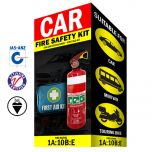Are you prepared for a Car Fire ?
A fire can happen anywhere, anytime and it’s important to always be prepared for what you would do if you had one in your Car.
There are no mandatory or legal requirements in Australia to have fire extinguishers in your personal vehicles (except for motorhomes and caravans*). But of course, having the right safety equipment to protect your car against fire, such as a fire extinguisher is essential to protect your passengers and vehicle.
Car fires statistics in Australia
It is difficult to locate statistics about car fire-related incidents in Australian states and territories, and even more challenging to find statistics that can be compared in a meaningful way.
The NSW Department of Fire and Emergency Services records actual vehicle fires that they have attended, so we can base our statistics on those.
The following table provide a limited snapshot of vehicle fire-related incidents in NSW (sourced on https://www.fire.nsw.gov.au/):
| 2018/19 | 2019/20 | 2020/21 | |
|---|---|---|---|
| NSW Vehicle Fires | 3,214 | 3,010 | 2,942 |
| NSW Total Fires | 22,321 | 22,013 | 17,703 |
| % of vehicle fires | 14.4% | 13.7% | 16.6% |
As you can see motor vehicle fires represent a large percentage (around 15%) of all fires attended by the NSW Fire Department.
Most common causes of a car fire in Australia?
While most modern-day vehicles are well-designed and very safe. they can still catch fire. Here are some reasons why:
- Car accidents
- Electrical System Failure
- Fuel System Leaks
- Overheating Engine
- Overheating Catalytic Converters
Remember once a vehicle is ablaze, it really doesn't matter what caused it. If your car is on fire, get out fast and get as far away from the car as possible.
What to do If a car fire occurs?
If you’re in a vehicle, you should immediately evacuate and never attempt to extinguish fires yourself.
if the fire is small and you are equipped with a Car Fire Extinguisher you can try extinguishing the fire.
- Get everybody out of the car.
- Call the fire service on 000.
- Do a headcount and let the fire service know if someone is missing.
- Do not go back inside.
- Remember Call triple zero (000).
What fire safety equipment should I have in my car?
Recommended fire and overall safety products for your personal motorized vehicle include:
* required for motorhomes and caravans.
While there are a few different types of fire extinguishers (water, foam, carbon dioxide, wet chemical), we recommend using a 1kg or 1.5kg dry chemical powder extinguisher (ABE). It has good performance, a small gross weight and physical size so anyone in the car can use it. It is a great multi-purpose fire extinguisher well suited for all types of vehicles.

Where to install your car extinguisher?
Car extinguishers must be installed in easily accessible locations. If you place it in your trunk, you might not have time to get to it when needed. We recommend installing it under the front passenger seat. It is also important to securely mount the extinguisher (with short self drilling pan head screws) to prevent rolling around or sliding during an accident.
Installing the mounting bracket in a Vehicle:
Since surface types vary, mounting screws are not included with our extinguishers and vehicle brackets. Please purchase screws or bolts specifically designed for the surface on which you will mount the fire extinguisher.
Remove mounting bracket from extinguisher by unlocking the clasp and pulling the bracket away from the extinguisher. Use strong screws to mount the bracket securely onto metal or another solid surface that can support the weight of the fire extinguisher. The mounting bracket must be secure so you can remove the extinguisher quickly in an emergency.
How to use a Car Fire Extinguisher?
Knowing how to operate a car fire extinguisher could save your life in an emergency.
The key to putting out a fire with a car extinguisher is to use the PASS strategy: Pull the pin, Aim the hose towards the base of the fire, Squeeze the lever, and Sweep the hose.
Remember: Fires double in size every 60 seconds so use a fire extinguisher for small, contained fires only. Leave immediately if you're unable to extinguish the fire and call 000.



